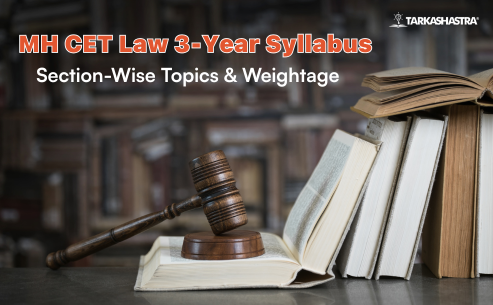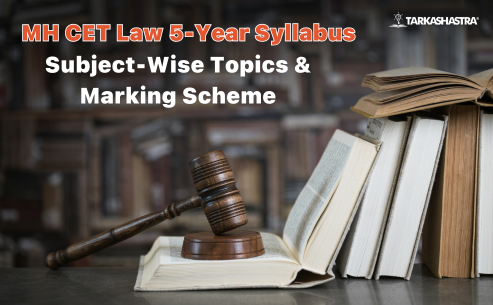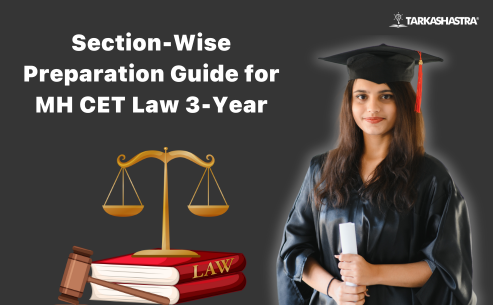The MH CET Law 3-Year syllabus 2026 is designed to test the core skills required for success in the 3-year LL.B program—legal reasoning, current affairs awareness, language proficiency, and logical thinking.
Conducted by the State CET Cell, Maharashtra, this exam follows a 120-question, 120-mark, no-negative-marking format, making syllabus clarity a major competitive advantage.
For 2026, the structure of the MH CET Law 3-Year syllabus remains consistent with the previous year. The paper evaluates candidates across four sections—English, General Knowledge & Current Affairs, Legal Aptitude & Legal Reasoning, and Logical & Analytical Reasoning.
A clear understanding of the MH CET Law 3-Year syllabus 2026 enables aspirants to plan smarter, prioritise high-scoring areas, and follow a targeted preparation approach.
MH CET Law 3-Year 2026 – Syllabus at a Glance
| Section | What It Tests | Importance |
| English (40 Marks) | RC, grammar, vocabulary | Highest scoring; accuracy-based |
| GK & Current Affairs (32 Marks) | CA, legal updates, static GK | Decisive for 90+ scorers |
| Legal Aptitude (24 Marks) | Principle–fact, basic law concepts | Application-based scoring |
| Logical Reasoning (24 Marks) | Puzzles, verbal logic, patterns | Speed + accuracy oriented |
MH CET Law 3-Year 2026 Exam Pattern Snapshot
Before diving into the MH CET Law 3-Year syllabus 2026, aspirants must clearly understand the official exam pattern. The MH CET Law 3-Year exam follows a simple yet highly strategic design: 120 questions, 120 marks, 120 minutes, and no negative marking.
This pattern ensures that students can maximise their score by attempting all questions, making an accurate understanding of section-wise weightage crucial for planning. The MH CET Law 3-Year syllabus 2026 is divided into four core sections, each assessing a different skill set needed for LLB: English proficiency, general awareness, legal aptitude, and analytical reasoning.
The exam is conducted online (CBT mode) in English and Marathi, and percentile scores are used for final merit ranking during CAP admissions.
MH CET Law 3-Year 2026 Exam Pattern
| Feature | Details |
| Mode of Exam | Online (Computer-Based Test) |
| Total Questions | 120 |
| Total Marks | 120 |
| Duration | 120 Minutes |
| Question Type | MCQs |
| Marks per Question | +1 |
| Negative Marking | No |
| Medium | English & Marathi |
| Scoring | Percentile-based |
| Sections | English, GK & Current Affairs, Legal Aptitude, Logical Reasoning |
Section-Wise Marks Distribution & Weightage (2026)
To use the MH CET Law 3-Year syllabus 2026 effectively, aspirants must understand how marks are allocated across the four sections. The exam distributes questions strategically to test reading ability, legal reasoning, factual awareness, and analytical decision-making.
The highest weightage in the MH CET Law 3-Year syllabus 2026 goes to English (40 marks), followed by GK & Current Affairs (32 marks)—together accounting for 60% of the total score. These two sections often decide the difference between an average score and a 90+ percentile performance.
Legal Aptitude and Logical Reasoning maintain equal importance at 24 marks each, focusing on principle-based reasoning and analytical patterns.
Aspirants should design their preparation plans according to these weights to maximise scoring potential.
MH CET Law 3-Year 2026 – Marks & Weightage Breakdown
| Section | No. of Questions | Marks | Weightage | Difficulty Level (2025 Trend) |
| English | 40 | 40 | 33% | Easy to Moderate |
| General Knowledge & Current Affairs | 32 | 32 | 27% | Moderate / Dynamic |
| Legal Aptitude & Legal Reasoning | 24 | 24 | 20% | Moderate |
| Logical & Analytical Reasoning | 24 | 24 | 20% | Moderate |
MH CET Law 3-Year Syllabus 2026: Section-Wise Topics
- Legal Aptitude & Legal Reasoning Syllabus (24 Marks)
The Legal Aptitude & Legal Reasoning section of the MH CET Law 3-Year syllabus 2026 evaluates your ability to apply legal principles to real-life fact situations. This is one of the most scoring yet misunderstood sections. It does not test deep law knowledge, but rather your ability to interpret principles logically and consistently.
This section typically includes Principle–Fact questions, scenario-based reasoning, and basic conceptual topics from Constitution, Torts, Contracts, Criminal Law, and legal terminology. Candidates who practice application-based questions daily score significantly higher.
A. What This Section Tests
- Application of legal principles to given facts
- Understanding of basic legal concepts
- Logical consistency in legal arguments
- Interpretation without assumptions
- Familiarity with legal maxims & recent legal updates
This section plays a crucial role in the MH CET Law 3-Year syllabus 2026, especially for aspirants targeting 90+ scores.
B. Important Topics to Prepare
| Topic Cluster | Key Subtopics | Why It Matters |
| Principle–Fact Application | Apply principle to case facts, choose most legally sound option | Forms 70–75% of section |
| Constitution Basics | Fundamental Rights, DPSPs, structure, powers | Foundation for many principle scenarios |
| Contracts | Offer, acceptance, consideration, breach | Frequently used in reasoning-based MCQs |
| Torts | Negligence, strict liability, vicarious liability | 1–2 predictable questions |
| Criminal Law (BNS/IPC) | Mens rea, culpability, offences | Helps interpret intent-based questions |
| Legal Maxims | Latin phrases like ubi jus ibi remedium | 2–3 direct scoring questions |
| Legal GK | Recent judgments, new laws, amendments | Adds easy bonus marks |
C. Daily & Weekly Preparation Strategy
Daily Practice
- 10–15 principle–fact questions
- 5 legal maxims
- 1 conceptual topic (Constitution/Contracts/Torts/Criminal Law)
Weekly Strategy
- 1 sectional test
- Revise all principles practiced
- Attempt a mixed-topic quiz (20–30 questions)
D. Common Mistakes to Avoid
- Reading beyond the given principle
- Overthinking when two options seem similar
- Spending more than 1 minute per question
- Memorising theory instead of practising application
E. Ideal Score Target
With proper planning based on the MH CET Law 3-Year syllabus 2026, aspirants can easily target: 18–20 marks out of 24 (Topper-level accuracy)
- General Knowledge & Current Affairs Syllabus (32 Marks)
The GK & Current Affairs section of the MH CET Law 3-Year syllabus 2026 carries 32 marks, making it the second-highest weightage area after English. This section is often the biggest score differentiator because it is factual, dynamic, and requires consistent weekly revision—not last-minute cramming.
This section tests a candidate’s awareness of major national and international developments, legal updates, statistical facts, and socio-political changes over the past year. Toppers typically score 24–26 marks simply by maintaining a disciplined reading and revision routine.
A. What This Section Tests
- Legal and non-legal current affairs (past 9–12 months)
- National and international developments
- Indian polity, economy, and government schemes
- Static GK (history, geography, science-tech)
- Awards, sports, and important appointments
- New laws, amendments, and major judgments
Because of its wide scope, this part of the MH CET Law 3-Year syllabus 2026 rewards accuracy, memory, and consistent updating.
B. High-Weight Topics to Focus On
| Area | Key Subtopics | Expected Weightage |
| Current Affairs (9–12 months) | Govt schemes, bills & acts, appointments, awards, international summits, sports | Highest |
| Legal Current Affairs | New criminal laws (BNS/BSA/BSS), key SC/HC judgments, legal developments | 4–6 questions |
| Indian Polity | President, Parliament, judiciary, Constitution basics | Recurring |
| Economy | Budget terms, inflation, banking basics | 2–3 questions |
| History (Modern) | Independence movement, reforms | Factual scoring |
| Geography | Indian rivers, capitals, world locations | Occasional |
| Science & Tech | ISRO missions, Nobel winners, innovations | 1–2 questions |
C. Ideal Daily–Weekly–Monthly Routine
Daily Routine
- 15 minutes of newspaper reading (The Hindu / Indian Express)
- 10–15 Current Affairs MCQs
- Update CA notes (events, judgments, appointments)
Weekly Routine
- Revise key events of the week
- 1 GK sectional test
- Sunday → 100-question CA quiz
Monthly Routine
- Revise monthly CA PDFs
- Consolidate legal current affairs separately (very important)
This structured routine ensures complete alignment with the MH CET Law 3-Year syllabus 2026 expectations.
D. Common Mistakes to Avoid
- Preparing only static GK instead of CA-heavy content
- Relying on last month’s preparation
- Ignoring legal current affairs
- Reading news without revision
- Not practising MCQs consistently
E. Ideal Score Target
A realistic and achievable goal for this section: 24–26 marks out of 32 (Strong performance benchmark)
- Logical & Analytical Reasoning Syllabus (24 Marks)
The Logical & Analytical Reasoning section of the MH CET Law 3-Year syllabus 2026 assesses a candidate’s ability to identify patterns, draw valid inferences, analyse arguments, and solve structured problems under time pressure. This section is moderate in difficulty but highly scoring for those who practice regularly.
This section blends analytical puzzles with verbal logic, and most questions can be solved quickly with the right approach. Toppers typically secure 18–20 marks here by prioritising accuracy and avoiding lengthy puzzles early in the exam.
A. What This Section Tests
- Pattern recognition
- Deductive and inductive reasoning
- Argument evaluation
- Diagrammatic logic
- Accuracy under time constraints
This section complements the MH CET Law 3-Year syllabus 2026, ensuring candidates demonstrate the sharp analytical thinking required in legal studies.
B. High-Yield Topics (Based on Previous Years)
| Topic Category | Examples | Importance |
| Analytical Puzzles | Linear arrangements, seating, grouping, matrix puzzles | Most time-consuming but high scoring |
| Verbal Logic | Syllogisms, assumptions, conclusions | Appears every year |
| Series | Alphabet series, number series, pattern completion | 3–4 questions |
| Coding–Decoding | Letter substitution, number patterns | Quick scoring |
| Blood Relations | Family-based questions | 1–2 questions |
| Direction Sense | Movement, orientation | Easy and predictable |
| Analogy/Classification | Identify relationships | Memory-based |
C. Preparation Strategy
Daily Routine (20–30 minutes)
- Solve 2 puzzles
- Practice 10 verbal logic questions
- Maintain shortcuts & pattern notes
Weekly Routine
- 2 sectional reasoning tests
- Revise mistakes from previous puzzles
- Practice diagram-based questions
Exam-Day Strategy
- Attempt quick topics first: series → coding → syllogisms
- Attempt puzzles only after securing at least 10–12 easy marks
- Never solve puzzles mentally—always draw diagrams
D. Common Mistakes to Avoid
- Attempting long puzzles first
- Not drawing diagrams for arrangements
- Guessing without eliminating options
- Random practice instead of topic-wise drills
E. Ideal Score Target
With structured preparation aligned to the MH CET Law 3-Year syllabus 2026, aspirants can aim for: 18–20 marks out of 24
- English Language Syllabus (40 Marks)
The English Language section is the highest-weightage component of the MH CET Law 3-Year syllabus 2026, carrying 40 marks. It is also one of the most scoring sections because questions are straightforward, rule-based, and predictable. This section often determines whether a candidate crosses the 90+ mark overall.
This section evaluates reading comprehension skills, vocabulary strength, grammatical accuracy, and the ability to understand and organise information logically. Consistent reading and practice-based preparation give the best results here.
A. What This Section Tests
- Reading comprehension & interpretation
- Grammar and sentence correctness
- Vocabulary usage and contextual understanding
- Ability to identify logical flow in paragraphs
- Error detection and correction
- Knowledge of idioms, phrases & one-word substitutions
This is a high-return section in the MH CET Law 3-Year syllabus 2026, ideal for boosting accuracy.
B. Likely Question Composition
| Component | What to Expect | Importance |
| Reading Comprehension (RC) | 2–3 passages on social, legal, or abstract themes; factual & inference questions | 8–10 marks |
| Vocabulary | Synonyms, antonyms, analogies, word usage | 8–10 marks |
| Grammar & Error Spotting | Subject-verb agreement, tenses, modals, modifiers, prepositions | 10–12 marks |
| Para-Jumbles & Para-OOO | Arrange sentences logically, odd-one-out | 5–6 marks |
| Cloze Test | Context-based fill-in-the-blanks | 3–4 marks |
C. Daily & Weekly Preparation Plan
Daily Routine
- Read 1 editorial (Indian Express / The Hindu)
- Learn 10–12 new vocabulary words
- Solve 10 grammar MCQs
- Practice 1 RC every alternate day
Weekly Routine
- Take 1 English sectional test
- Revise vocabulary notebook
- Attempt 50–60 mixed MCQs covering grammar + vocabulary + RC
- Practice 2 para-jumbles + 2 cloze tests
D. High-Impact Tips (Based on Topper Patterns)
- Read questions before reading the RC passage
- Use rule-based elimination for grammar questions
- For para-jumbles, identify:
✔ connectors (however, therefore, although)
✔ pronoun references
✔ chronological clues
- Practice vocabulary in context, not rote memorisation
- Avoid reading RCs slowly—skim, then scan
E. Common Mistakes to Avoid
- Ignoring vocabulary revision
- Reading RCs word-for-word
- Learning grammar rules without practice
- Panicking when unfamiliar words appear (context usually helps)
F. Ideal Score Target
A well-prepared aspirant aligned with the MH CET Law 3-Year syllabus 2026 can aim for: 30–34 marks out of 40 (Top scorers often reach 34–36)
Topic-Wise Weightage (Predicted for 2026)
While the State CET Cell does not officially release topic-wise weightage, the trends from the past 4–5 years help predict how the MH CET Law 3-Year syllabus 2026 is likely to be distributed across key topics. These predictions allow aspirants to prioritise high-yield areas and plan revision more effectively.
The exam typically maintains a balanced structure, but certain topics like Principle–Fact application, Current Affairs, RC passages, and Verbal Logic consistently carry more marks. Focusing on these areas improves scoring efficiency.
Predicted Topic-Wise Weightage for MH CET Law 3-Year 2026
| Section | High-Weight Topics | Expected Share |
| English | RC, Grammar, Vocabulary | 50–55% |
| GK & Current Affairs | Current Affairs, Legal CA | 60% |
| Legal Aptitude | Principle–Fact Questions | 70–75% |
| Logical Reasoning | Verbal Logic + Series | 60% |
These trends indicate that the MH CET Law 3-Year syllabus 2026 will heavily reward:
- smart reading (English)
- consistent news revision (GK)
- daily principle-based practice (Legal Aptitude)
- quick logic drills (Reasoning)
How to Use the MH CET Law 3-Year Syllabus 2026 to Prepare Effectively?
Understanding the MH CET Law 3-Year syllabus 2026 is only the first step—using it strategically is what helps students score 90+ and reach top colleges like GLC Mumbai or ILS Pune.
Since the syllabus clearly defines four distinct skills (reading, legal reasoning, general awareness, and analytical logic), aspirants should create a preparation plan that targets each area differently instead of studying everything uniformly.
Begin by identifying high-weightage components of the MH CET Law 3-Year syllabus 2026, such as English (40 marks) and GK (32 marks).
These two sections contribute more than half of the total score and must be prioritised daily. Next, dedicate consistent practice to principle–fact questions from Legal Aptitude and short, accuracy-driven drills for Logical Reasoning.
Weekly mock tests and monthly revisions ensure full coverage of the MH CET Law 3-Year syllabus 2026, while avoiding last-minute overload. Smart planning—not heavy studying—is the key to mastering this exam.
Related Articles for MH CET Law (3-Year)
Preparing for MH CET Law (3-Year) requires a clear understanding of the syllabus, exam pattern, eligibility norms, and preparation strategies. To help you build a strong foundation and stay updated with every aspect of the exam, here are some articles you can explore.
- When to Start MH CET Law 3-Year 2026 Prep? Preparation Plan for Graduates
- MH CET Law 3-Year Exam Pattern & Marking Scheme Explained (2026)
- MH CET Law 3-Year 2026 Registration Guide: Step-by-Step Application Process
- MH CET Law 3-Year 2027 Course – Crack GLC, ILS & Top Maharashtra Law Colleges
- MH CET Law 3-Year Admit Card 2026: Release Date, Download Process & Key Instructions
These articles will support you throughout your preparation journey—from understanding the basics to choosing the right colleges and more.
Conclusion
Decoding the MH CET Law 3-Year syllabus 2026 is the first step—but converting that understanding into a high score requires the right mentorship, strategy, and consistency. When you know exactly what each section expects, your preparation becomes sharper, faster, and more result-driven.
This is where Tarkashastra gives you a decisive advantage. With expert-led Legal Aptitude training, simplified Current Affairs capsules, high-accuracy English practice modules, and reasoning drills designed exactly as per CET trends, Tarkashastra ensures that no part of your MH CET Law 3-Year syllabus 2026 remains uncovered.
Our alumni-designed mock tests, personalised guidance, and structured study plans help aspirants push beyond 90+ scores and secure seats in top law colleges like GLC Mumbai, ILS Pune, and Ambedkar Law College.
Your law school journey begins with the right preparation—and Tarkashastra prepares you to win.
FAQs – MH CET Law 3-Year Syllabus 2026
1. What is the syllabus for MH CET Law 3-Year 2026?
The MH CET Law 3-Year syllabus 2026 includes four sections—English, General Knowledge & Current Affairs, Legal Aptitude, and Logical & Analytical Reasoning. Each section evaluates a different skill set required for the LLB program.
2. Does the syllabus for MH CET Law 3-Year change every year?
No. As per recent trends the MH CET Law 3-Year syllabus 2026 remains the same as the previous cycle, with the same structure and distribution of marks.
3. Which section has the highest weightage in the MH CET Law 3-Year exam?
English carries 40 marks, making it the highest-weighted section in the MH CET Law 3-Year syllabus for 2026.
4. What topics are most important for Legal Aptitude?
Principle–Fact questions, basic Constitutional Law, Contracts, Torts, Criminal Law (BNS/IPC basics), Legal Maxims, and recent legal developments.
5. How many current affairs do I need to study for the exam?
Prepare 9–12 months of current affairs, with special focus on government schemes, appointments, bills, international events, and legal updates.
6. Is Logical Reasoning difficult in the MH CET Law 3-Year?
It is moderate in difficulty. With daily practice of puzzles, syllogisms, series, and coding–decoding, candidates can easily score 18–20 marks.
7. How important is English for MH CET Law 3-Year 2026?
Very important. English alone contributes 33% of the total score and is the most reliable scoring section.
8. Do I need prior law knowledge for Legal Aptitude?
No. The MH CET Law 3-Year syllabus 2026 tests the application of simple legal principles—not detailed law knowledge.
9. Is there negative marking in MH CET Law 3-Year 2026?
No. There is no negative marking, so candidates must attempt all 120 questions.
10. How should I use the syllabus for daily preparation?
Focus on English + GK daily, practice Legal Aptitude principles regularly, and solve short reasoning drills. Complete the MH CET Law 3-Year syllabus 2026 in phases with weekly revision.
11. Can I complete the syllabus in 4–6 months?
Yes. With consistent study (2–3 hours/day) and regular mock tests, completing the MH CET Law 3-Year syllabus 2026 in 4–6 months is realistic.
12. How can Tarkashastra help me prepare the MH CET Law 3-Year syllabus effectively?
Tarkashastra offers structured study plans, expert-led lectures, law-focused GK capsules, principle-based Legal Aptitude training, 60+ mocks, and personalised mentorship—making it the perfect coaching support for MH CET Law 3-Year aspirants.







